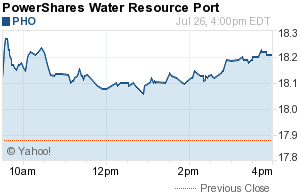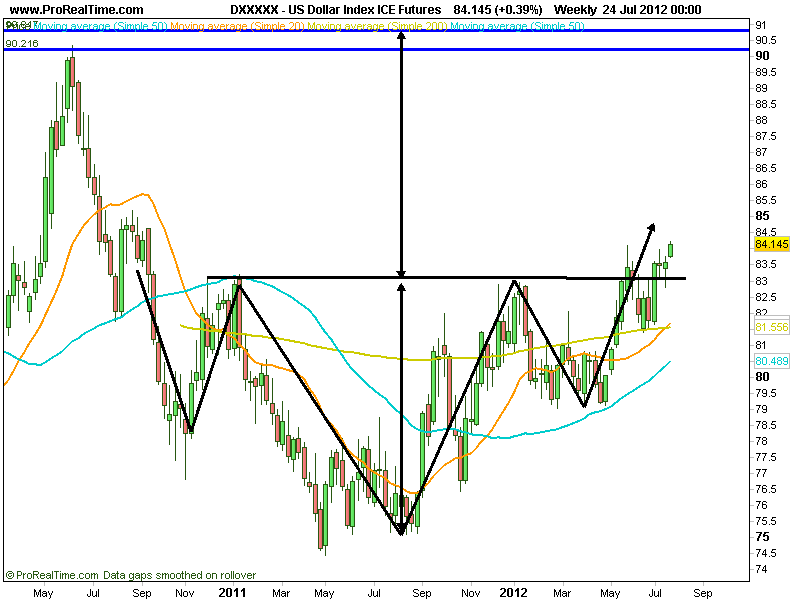Timing & trends
The second of two periods of seasonal strength in the energy sector is approaching. The average optimal time is from July 24th to October 3rd. Thackray’s 2012 Investor’s Guide notes that a trade in the S&P Energy Index has been profitable in 10 of the past 15 periods.
Annual recurring reasons for seasonal strength include strong demand for energy used for air conditioning and declining refined product inventories when refiners are converting their production from gasoline for the summer driving season to heating oil for the winter heating season. Added to this year’s outlook is higher than average temperatures in North America this summer and forecasts for more of the same in August. In addition, U.S. heating oil and gasoline inventories already are at five year lows even before the annual conversion process has started setting the stage for significantly higher refined product prices this fall. Prices already have started to move higher. Since mid-June natural gas prices have jumped 42 per cent, wholesale gasoline prices have increased 16 per cent and heating oil prices have gained 16 percent.
International events also could impact crude oil and refined product prices. Iran has threatened on several occasions to shut down the Straits of Hormuz in response to the West’s growing sanctions designed to encouraging curtailment of Iran’s nuclear program. Most of the world’s crude oil shipments exported from the Middle East must pass through the Straits of Hormuz.
The Canadian energy sector could receive a boost this summer following news on Monday that China’s CNOOC made a “friendly” cash offer to acquire Nexen for US$15.1 billion. The offer came at a 61 per cent premium to Nexen’s closing price on Friday. The offer suggests that Canadian oil and gas producer stocks are undervalued and could prompt additional buying in the sector.
Ironically, energy equities and related ETFs have recorded only modest gains in July despite higher energy prices. Energy equities remain well below highs set in March and only began to outperform the S&P 500 Index and TSX Composite last week. Underperformance has been for good reason. West Texas Intermediate crude oil prices averaged US$88 per barrel in the second quarter, down from US$102 per barrel in the second quarter last year. Second quarter earnings and cash flow will be down substantially on a year-over-year basis. Investors have been reluctant to own the sector prior to the release of “difficult” second quarter results. The tip off will come this week when major Canadian and U.S. energy companies are scheduled to release results. If energy equity prices move higher despite bad news, the stage is set for a significant recovery by the sector into this fall.
On the charts, the sector on both sides of the border has an improving technical profile. The S&P Energy Index broke to a 10 week high on Friday, the Philadelphia Oil Services Index broke above a reverse head and shoulder pattern last week and the TSX Energy Index will complete a reverse head and shoulders pattern on a break above 245.05. Preferred strategy is to accumulate energy equities and related ETFs at current or lower prices for a seasonal trade lasting until October.

A wide variety of Exchange Traded Funds in the energy sector as well as crude oil, natural gas and gasoline are available in North American equity exchanges. U.S. exchanges list 30 Energy ETFs. A list is available at http://etfdb.com/etfdb-category/energy-equities. Another 24 U.S. based ETFs trade oil, gasoline and natural gas. A list is available at http://etfdb.com/etfdb-category/oil-gas. The most actively traded U.S. listed ETF is the Energy Select Sector SPDR (XLE $67.28). Canadian exchanges list seven energy equity ETFs and eleven oil and natural gas ETFs. The most actively traded Canadian equity ETF is iShares on the S&P/TSX Capped Energy Index (XEG $15.06 Cdn.).
Don Vialoux is the author of free daily reports on equity markets, sectors, commodities and Exchange Traded Funds. He is also a research analyst at Horizons Investment Management, offering research on Horizons Seasonal Rotation ETF (HAC-T). All of the views expressed herein are his personal views although they may be reflected in positions or transactions in the various client portfolios managed by Horizons Investment. Horizons Investment is the investment manager for the Horizons family of ETFs. Daily reports are available at http://www.timingthemarket.ca/

“Is water the gold of the 21st century?” asks Fortune. Answer: Yes, water is the New Gold for investors this century.
In 2010 global water generated over a half trillion dollars of revenue. Global world population will explode from 7 billion today to 10 billion by 2050, predicts the United Nations. And over one billion “lack access to clean drinking water.”
Climate and weather patterns are changing natural water patterns. And industrial pollution is making water a scarce commodity. So the good news is that huge “opportunities exist for businesses that can figure out how to keep the pipes flowing.”
Yes, it’s a hot market.
….read more analysis of the following topics HERE
- Population, the explosive driver in the demand for ever-scarcer water
- China’s mining “new gold,” for agriculture, industry, economic leadership
- New Gold hidden in steaks, auto tires, chickens, designer jeans
- Get your feet wet in wet stocks and watery ETFs



Late in the afternoon today (July 24th) word came via Bernanke pal Jon Hilsenrath that the Fed could be moving closer to taking additional actions to spur growth. There’s little doubt in my mind that this is indeed the case. In a recent note Bridgewater estimated that in the past few months global growth has slowed from a 3.3% rate down to 1.9%. This lower global growth should inevitably also cause lower inflation, leading developed market central banks to loosen policy via Quantitative Easing while emerging market central banks choose rate cuts. Whether you agree with these policies or not, I believe recent economic developments will cause the Fed to act.
Astute observers have noted that the recent plunge in US Treasury yields has primarily been a decline in real yields. Ten year break-evens, as an example, have declined only ~20bps since May down to 2%. Ten year nominal yields have dropped over 50bps in the same time period falling under 1.40% as of today’s close. Despite Chairman Bernanke profession that “additional tools” remain in play, I believe we will see additional large scale asset purchases “LSAP’s” in the form of Agency Mortgage Backed Securities. What will this accomplish and how is it different than last time?
Just as the repeated usage of an anti-biotic can have diminishing benefits, I believe that the impact of QE too will see a diminished impact. Here’s two reasons why:
1.) Little impact will flow through to mortgage borrowers
2.) Other fixed income “risk asset” yields are substantially lower today:

“With summer doldrums well and truly upon us markets have been drifting lower on low volume and trying to hold their May lows. Most metals and certainly gold have performed better and seem to have bottoms in place. As we note in the updates there are three companies on the HRA list that have been getting a lot more attention from traders and several others that are getting traction based on results to com.”.
“Major markets have not been cooperating thanks to debt issues that won’t go away soon. There are plenty
of headwinds still but commodity prices, though lower, are all at levels that makes them hard to pin the
blame on for weak markets.”
“Gold has defended its recent lows well, though not without a couple of scares along the way. Whatever the day to day comments of central bankers, few can see a way out of the current crises that doesn’t involve massive money printing. The US may have the lowest yields but it’s done the least about controlling expenditures so Washington will be printing right along with everyone else. Gold will benefit.”
“The Dollar continues to be helped by its safe haven status. Every disappointment out of Europe has
generated upticks in the US Dollar Index which is now trading near a two year high”.
…. read the entire 5 page analysis HERE
US Dollar Chart



















